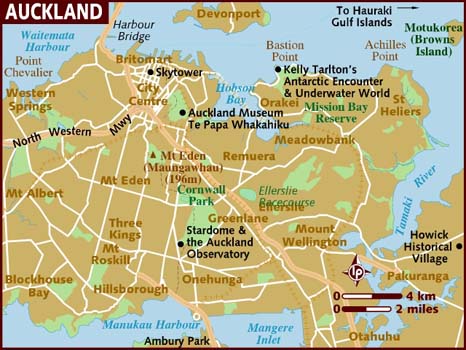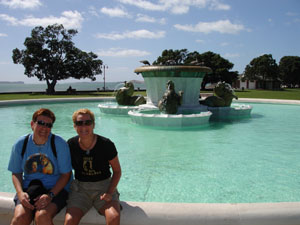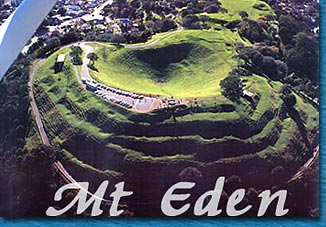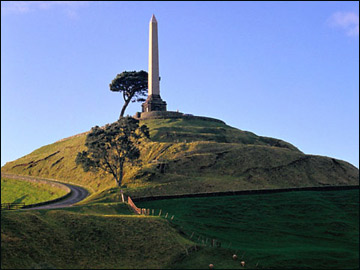

National Anthem God of Nations at Thy feet, Guard Pacific's triple star Men of every creed and race, From dissension, envy, hate, Peace, not war, shall be our boast, Lord of battles in Thy might, Let our love for Thee increase, From dishonour and from shame, May our mountains ever be Guide her in the nations' van, © Lotolux.com/NZ info 2009-2013 All rights reserved - Karin Oosterveen - Contact- Lotolux/NZ info is a non profit web site. All articals, images, and other works are copyrighted to the original owners. |
Auckland |
|
The Auckland metropolitan area or Greater Auckland, in the North Island of New Zealand, is the largest and most populous urban area in the country with over 1.3 million residents, 31 percent of the country's population. Demographic trends indicate that it will continue to grow faster than the rest of the country.
Increasingly cosmopolitan, Auckland also has the largest Polynesian population of any city in the world.
It is a conurbation, made up of Auckland City (excluding the Hauraki Gulf islands), North Shore City, and the urban parts of Waitakere and Manukau cities, along with Papakura District and some nearby urban parts of Rodney and Franklin Districts. In Māori its name is Tāmaki-makau-rau, or the transliterated version of Auckland, Ākarana.
Auckland lies between the Hauraki Gulf of the Pacific Ocean to the east, the low Hunua Ranges to the south-east, the Manukau Harbour to the south-west, and the Waitakere Ranges and smaller ranges to the west and north-west. The central part of the urban area occupies a narrow isthmus between the Manukau Harbour on the Tasman Sea and the Waitemata Harbour on the Pacific Ocean.
It is one of the few cities in the world to have harbours on two separate major bodies of water.



Famous sites
The following is a list of tourist attractions and landmarks in the Auckland metropolitan area:panoramic views.
Attractions and Buildings
- Auckland Civic Theatre - a famous heritage atmospheric theatre in downtown Auckland. It is still operating as a theatre and was renovated in 2000 to its original condition.
- Harbour Bridge - connecting Auckland and the North Shore, an iconic symbol of Auckland.
- Auckland Town Hall - with its concert hall considered to have some of the finest acoustics in the world, this 1911 building serves both Council and entertainment functions.
- Auckland War Memorial Museum - a large multi-exhibition museum in the Auckland Domain, known for its impressive neo-classicist style.
- Aotea Square - the hub of downtown Auckland besides Queen Street, it is often the site of crafts markets, rallies or arts festivals.
- Britomart Transport Centre - the main downtown public transport centre located in a historic Edwardian building.
- Eden Park - the city's primary stadium and a frequent home for All Blacks rugby union and Black Caps cricket matches. It will be the location of the 2011 Rugby World Cup grand final.
- Karangahape Road - known as "K' Road", a street in upper central Auckland famous for its bars, clubs and smaller shops.
- Kelly Tarlton's Antarctic Encounter & Underwater World - a well-known aquarium and antarctic environment in the eastern suburb of Mission Bay, built in a set of former sewage storage tanks, showcasing penguins, turtles, sharks, tropical fish, sting rays and other marine creatures.
- MOTAT - Auckland's Museum for Transport and Technology, at Western Springs.
- Mt Smart Stadium - a stadium used mainly for rugby league and soccer matches. Also the site of many concerts.
- Ponsonby - a suburb and main street west of central Auckland known for arts, cafes and culture.
- Queen Street - the main street of the city, from Karangahape Road down to the harbour.
- Sky Tower - the tallest free-standing structure in the Southern Hemisphere, it is 328 m (1,076 ft) tall and has excellent panoramic views.
- Vector Arena - events centre in downtown Auckland completed in As of 2007. Holding 12,000 people, it can be used for sports and concert events.
- Viaduct Basin - a marina and residential development in downtown Auckland, the venue for the America's Cup regattas in 2000 and 2003.
- Western Springs Stadium - a natural amphitheatre used mainly for speedway races, rock and pop concerts.



Landmarks and Nature
- Auckland Domain - one of the largest parks of the city, close to the CBD and having a good view of the harbour and of Rangitoto Island.
- Mount Eden - a volcanic cone with a grassy crater. As the highest natural point in Auckland City, it offers 360-degree views of Auckland and is thus a favorite tourist outlook.
- Mount Victoria - a volcanic cone in North Shore City offering a spectacular view of Auckland. A brisk walk from the Devonport ferry terminal, the cone is steeped in history, as is nearby North Head.
- One Tree Hill (Maungakiekie) - a volcanic cone that dominates the skyline in the southern, inner suburbs. It no longer has a tree on the summit (after a politically motivated attack on the old tree) but is still crowned by an obelisk.
- Rangitoto Island - guards the entrance to Waitemata Harbour, and forms a prominent feature on the eastern horizon.
- Great Barrier Island - the largest island in the Hauraki Gulf with a rich history of mining, kauri logging and remote landscape making it popular for tramping, biking, kayaking, diving and fishing.
- Waiheke Island - the second largest island in the Hauraki Gulf and is well known for its beaches, forests, vineyards and olive groves.


One Tree Hill
Immigration
The proportion of Asians and other Non-European immigrants has increased during the last decades due to immigration, and the removal of restrictions directly or indirectly based on race. Immigration to New Zealand is heavily concentrated towards Auckland (partly for job market reasons). This strong focus on Auckland has led the immigration services to award extra points towards immigration visa requirements for people intending to move to other parts of New Zealand.
The following table shows the ethnic profile of Auckland's population, as recorded in the 2001 and 2006 New Zealand Census. The percentages add up to more than 100%, as some people counted themselves as belonging to more than one ethnic group. Figures for 2006 refer to the whole Auckland Region, not just the urban area. The substantial percentage drop of 'Europeans' was mainly caused by the increasing numbers of people from this group choosing to define themselves as 'New Zealanders' - even though this was not one of the groups listed on the census form.
Ethnic Group |
2001 (%) |
2001 (people) |
2006 (%) |
2006 (people) |
European |
66.9 |
684,237 |
56.5 |
698,622 |
14.9 |
152,508 |
14.4 |
177,936 |
|
14.6 |
149,121 |
18.9 |
234,222 |
|
11.5 |
117,513 |
11.1 |
137,133 |
|
n/a |
n/a |
1.5 |
18,555 |
|
Others |
1.3 |
13,455 |
0.1 |
648 |
'New Zealanders' |
n/a |
n/a |
8.0 |
99,258 |
Total giving their ethnicity |
|
1,022,616 (individuals) |
|
1,237,239 (individuals) |
The 2006 Census also provides information about the multilinguality of the region. Accordingly, 867,825 people in the Auckland Region spoke one language only, while 274,863 spoke two, and 57,051 could converse in three or more languages.
